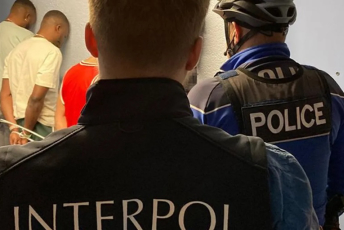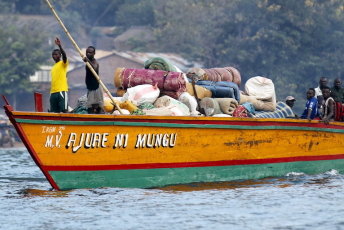Belgium and the Netherlands (especially the cities of Antwerp and Rotterdam) have overtaken Spain as Europe’s main entry points for cocaine coming from Latin America. The 65.6 tonnes of cocaine intercepted at the port of Antwerp in 2020 nearly doubled in 2022. And Morocco is a key link in the chain.
When the Netherlands opened its cannabis market in the 1970s, Dutch and Belgian nationals of Moroccan descent took advantage of their close family links with cannabis growers in the northern mountains of Morocco’s Rif region. What started as trafficking of the sought-after hashish slowly extended to cocaine, a more lucrative drug.
The powerful Mocro Maffia drug cartel emerged from this trade in the 1990s, controlling a third of Europe’s cocaine market, and working mainly from Belgium and the Netherlands.
Latin American drug traffickers have increasingly used Morocco and other Maghreb countries, as well as traffickers based in both Morocco and Europe, like the Mocro Maffia, in their transnational cocaine trade. Colombian and Mexican cartels used the group to facilitate the drug route to Spain via the southern city of Algeciras through their connection with Spanish traffickers on the Atlantic coast.
But this route has become increasingly dangerous, with Spanish and Italian authorities tightening their border control and search operations, says criminologist and co-founder of Crim’HALT, Fabrice Rizzoli. Traffickers are therefore using Belgium and the Netherlands as their preferred ports. The sheer size of and container traffic through these ports makes it difficult for authorities to address the problem.
In its 2021 report, the Rotterdam port authorities highlighted that ‘subversive crime is high on our agenda, tackling [it] is a challenge facing society as a whole … We do not want criminals to use the port for nefarious ends. We are working with various agencies in the port to maintain security and combat drugs-related crime.’
Corruption is the key enabler in the cocaine trafficking chain from Latin America to Rotterdam and Antwerp via Africa. For Latin American drug cartels, the Mocro Maffia’s ability to corrupt political actors makes them strategic allies.
Audio exchanges intercepted through the Sky ECC app reveal how Mocro Maffia members boasted about bribing customs officers in the Port of Dakar, which is used as a transit point. Likewise, dockers in Antwerp and Rotterdam are paid up to €100 000 to relocate containers to avoid police and customs control. Without this, drug traffickers would have limited access to the drug consignments sent from Latin America.
Rizzoli says Belgium and the Netherlands are also both money laundering centres. Antwerp, the world capital of diamond processing, is a destination for washing drug proceeds (sometimes paid in diamonds), while the real estate sector in Belgium serves as a primary route for money laundering.
The Netherlands remains an ideal place for drug traffickers seeking to reinvest their money, with a reported €16 billion laundered annually due to its large, internationally-oriented and highly-digitised financial sector, and its open and trade-oriented economy. The creation of shell companies is a key conduit for laundering money in the Netherlands.
The Mocro Maffia uses violence to expand its reach in the cocaine trafficking market. In the past decade, over 100 people have died due to violence between the Mocro Maffia and Belgian drug traffickers. In November 2017, two members of the group reportedly killed a man in Marrakech, Morocco, possibly linked to drug trafficking. The group is also suspected of being linked to the murder of the son of a Moroccan judge.
Derk Wiersum, an Amsterdam lawyer specialising in organised crime and drug trafficking networks, and Peter R. de Vries, an investigative journalist who reported on drug trafficking, were assassinated in 2019 and 2021 respectively, allegedly by the Mocro Maffia. And recently a Belgian girl, 11, of Moroccan origin was killed when her parents’ home was shot at – allegedly by the group.
In September 2021, a security alert was raised by Dutch security services, who believed that Prime Minister Mark Rutte was under threat from members of the Mocro Maffia. Likewise, Dutch Crown Princess Catharina-Amalia is protected by heavy security following rumours of kidnapping threats reportedly linked to the group.
One reason for the Mocro Maffia’s success in the Netherlands is that disorganised public authorities are faced with organised criminality, says Hans Werdmölder, author of Nederland Narcostaat.
The authorities and law enforcement must raise their game to counter this threat. For example, adequate modern surveillance equipment such as drones, mobile scanners and robots are lacking in the Netherlands, Belgium and Morocco (and in North Africa generally). Installing or modernising such equipment – and training law enforcement to use these tools effectively – could help detect more drugs at the transit hubs in Morocco and the Rotterdam and Antwerp ports. And graft needs to be addressed.
Here Rizzoli suggests a different approach, believing the authorities should change their mindset about drugs. Rather than focusing on stopping the drug trade, he says, measures should be taken to curb the associated violence.
Rizzoli suggests Italy could be a good example to follow. Following drastic legislation and judicial measures taken in Italy in the 1980s, he says, violence related to drug trafficking has almost disappeared.
Instead of judicial condemnation, Italian authorities punish drug traffickers financially, targeting their assets. He says around $6 billion in assets are confiscated from drug traffickers yearly in Italy, of which 60% are eventually permanently confiscated. These assets are redistributed to non-governmental organisations. This shows citizens concrete results of the authorities’ fight against drug traffickers and the mafia.
The Mocro Maffia is clearly a serious threat to both the European Union (EU) and Africa. In a short time, the organisation has become a major trafficking group in Europe. Its links with organised criminal groups in Morocco and Latin America make it a persistent and growing threat to North African states and populations.
Continued action, similar to the operations that led to the arrest of 49 organised criminal actors in November 2022, and asset-linked approaches by the EU and North African authorities are needed. Without this, the Mocro Maffia is on an unchallenged pathway to increasing its trafficking web between the two continents.
ENACT project







